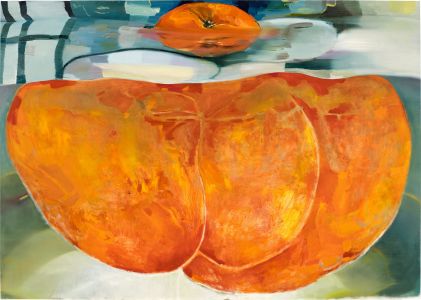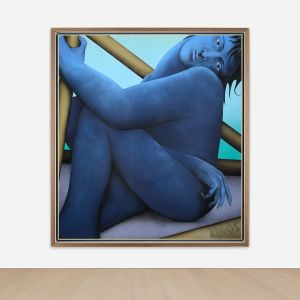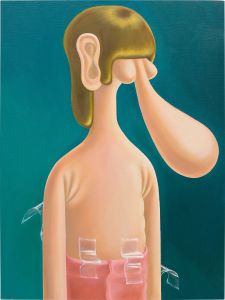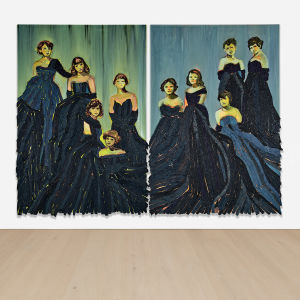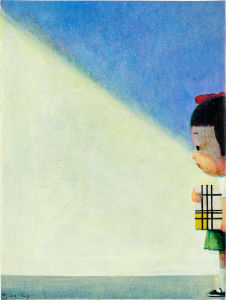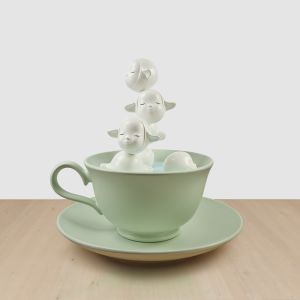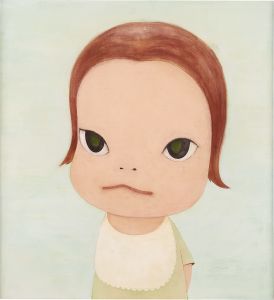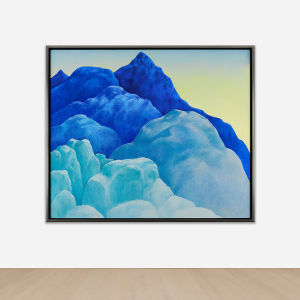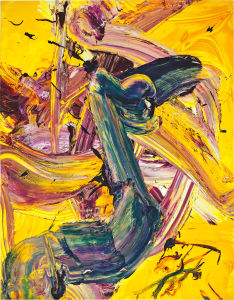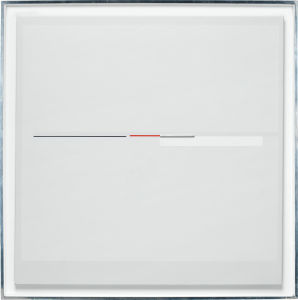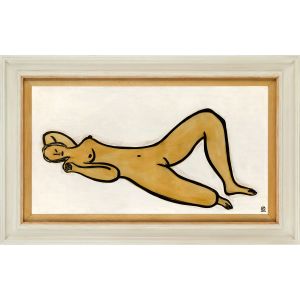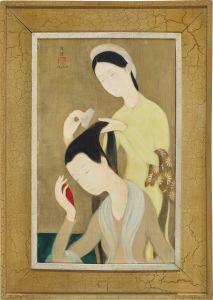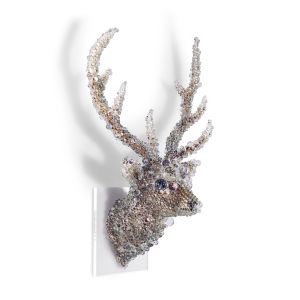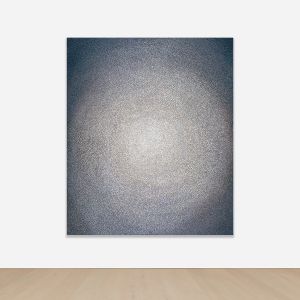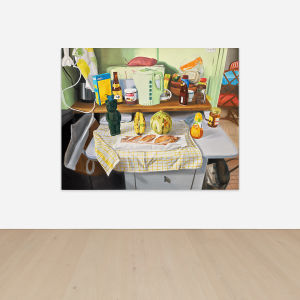
Yoshitomo Nara's Baby Blue stands as a definitive masterpiece from one of Japan's most celebrated contemporary artists, who has unequivocally achieved rock star status on the global art stage. At the heart of his practice lies the iconic, adored ‘Nara girl’, a protagonist whose narrative and worlds have evolved through Nara’s oeuvre in tandem with the artist’s personal and artistic growth. Instantly recognisable with their large, chickpea-shaped heads and intensely expressive eyes that convey deep emotion, these cherubic faces are often lit with a playful mischief that belies their age. This intriguing duality is a hallmark of Nara’s artistic expression, inviting viewers to delve into the tensions between innocence and experience. Through this interplay, Nara connects with his audience on a profoundly universal level, exploring themes of childhood, identity, and the intricate complexities of human emotion.
Painted at the turn of the millennium in 1999, Baby Blue emerged during a pivotal moment in Nara’s career, with artworks from this period being particularly coveted, as evidenced by Nara’s top two results at auction being canvases created just one year later. Baby Blue was first unveiled at an exhibition of Nara’s work hosted by the Marianne Boesky Gallery in New York that Autumn, marking his first solo show in the city. Nara’s debut received high praise, including that of the esteemed The New York Times critic Roberta Smith, who complimented Nara’s ‘cast of cute but demonic cartoon toddlers’i who ‘pack a potent visual punch’.i
Smith articulates how this visual impact arises from the contrast of high abstraction with popular culture, with Nara’s angelic-devilish subjects ‘rendered in clear buoyant shapes, like toys. But their big beach-ball heads feature clamped, lozenge-shaped mouths and somewhat slanted green eyes that smoulder resentfully.’i
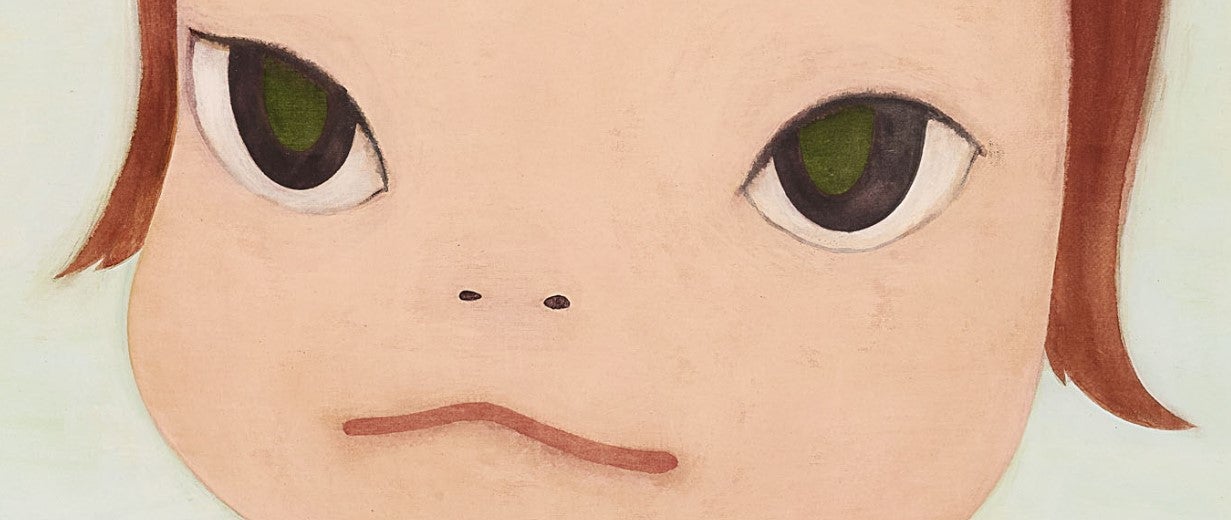
Detail of the present lot The colours are ‘rich, odd, deliberate and slightly nostalgic: beautiful pastels against glowing browns that evoke illustrated children's books from an earlier era’i. And the figures are set against ‘unusually seductive [surfaces], dense and powdery like pastel but with the evenness of stain painting’i. Indeed, Smith’s summary of the key characteristics of the most significant Nara girl paintings is beautifully exemplified in Baby Blue, which encapsulates these very qualities.
“If they had a collective motto, it would probably be ''Don't throw a tantrum, get even.''
— Roberta Smith for The New York Times, 5 November 1999Marriane Boesky, the renowned Manhattan art dealer, was influential in the early career of Nara, playing a crucial role in his initial exposure to the U.S. art scene. Another notable artist Boesky supported at this time was Nara's peer from Japan, Takashi Murakami. The pair’s paths intersected more deeply in 1998, a year before Baby Blue’s creation, when both artists were invited to teach a semester at the University of California, Los Angeles (UCLA). Despite contrasting personalities—Murakami being an extrovert and Nara more reserved, spending his time exploring the West Coast’s record stores and pop culture treasures in his battered car—they forged a friendship and began to plot a ‘new pop revolution’ii to challenge the dominant and conservative Japanese art world from the outside.
Yoshitomo Nara: The Little Star DwellerTo gain a deeper understanding of this incentive, it is beneficial to reflect on Nara's formative experiences, especially as his memories—particularly from childhood—play a crucial role in the shaping of his creative process. Nara was born in 1959 in Hirosaki, a remote town in picturesque Aomori, the northernmost province of Japan, located approximately 700 kilometers north of Tokyo. As the youngest of three boys, with siblings nearly a decade older, he spent much of his childhood embarking on adventures in solitude, perceiving his hometown as ‘filled with debris and ghosts.’ He often found solace in the enchanting worlds of Japanese and American comic books, as well as European folk tales, with Aesop's Fables, Hans Christian Andersen's fairy tales, and the Brothers Grimm among his favorites. His best friend was the stray cat his family took in, and has reflected that he ‘could communicate better with animals, without words, than verbally with humans.’iii
Nara's fascination with folklore and fairy tales is evident in the whimsy and fantastical elements of his work, while his feelings of isolation and loneliness during childhood are mirrored in the solitary figures he depicts. Moreover, we can trace a connection to these early influences through his relationship with animals; such as the protagonist of Baby Blue bearing a striking resemblance to a feline, characterised by downturned, cat-shaped emerald green eyes and a mouth that gently curves like that of a cat.
During his teenage years, Nara relocated to Tokyo and at the age of 21, onwards to Nagakute to pursue a fine art master's degree, which he obtained in 1987 from the Aichi University of the Arts. In 1988, Nara, having been inspired by his visit to Documenta in Kassel a year earlier, decided to continue his formal training in art in Germany. He found the Japanese education system too restrictive and was drawn to the autonomous learning style he encountered in Europe.
Yoshitomo Nara reflects on his childhood through to his time in Germany, 2023
Video Courtesy of Albertina Museum
At the esteemed Kunstakademie Düsseldorf, he studied under the Neo-Expressionist A. R. Penck while being surrounded by other notable artists who also taught at that time, including the Bechers and Gerhard Richter. Although the language barrier presented an initial challenge, it pushed him to use his art as a means of communication. He began to eliminate unnecessary background elements and heavy outlines, choosing instead to concentrate solely on his subjects, determining that ‘each painting needs only to speak of one thing’iv. Following the completion of his studies in 1993, Nara moved to Cologne and lived in a collective in a Bauhaus building until 2000, when he moved back to Japan following his major exhibition at the Yokohama Museum of Art that year.
During this time, Nara broadened his artistic vocabulary by fusing elements of Japanese and Western pop culture he was drawing influence from. In the early 1990s, his signature depictions of the little girl often conveyed a hostile, violent undertone reflective of adolescent rebellion, characterised by bold outlines and playful props like toys or weapons. However, by the late 1990s, his approach evolved into a softer expression, as exemplified in the current painting, where pastel colors dominate and a more refined, subtle technique has been mastered.
Baby Blue
In Baby Blue, the subject wears a pistachio-coloured baby-doll dress, reminiscent of a child's nightgown. Her half-smile radiates a blend of innocence and mischief, heightened by the mystery of her arms tucked away behind her back, beckoning us to wonder what secret she holds. This playful act stirs a universal maternal instinct in the viewer as we speculate on the nature of the concealed object and potential danger it might harbour. However, as the child meets our gaze with her large puppy eyes, her gentle expression melts away any frustration, replacing it with a sense of warmth.
Set against a creamy jade green surface composed of delicate, layered hues, the background evokes a deep sense of vast atmospheric space that appears to stretch into infinity. This play on spatial perceptions is reminiscent of Yayoi Kusama's art. However, while Kusama creates her immersive environments using repeating patterns—most notably nets and polka dots—Nara achieves a similar effect by integrating subtly varied pigments across multiple layers throughout his painting process. The result is a softly rendered, almost ethereal quality, where what first appears as a single wash of colour gradually unfolds to reveal intricate nuances of hue.
Baby Blue’s bob haircut flicks upwards softly at its ends, infused with reddish tones that bring to mind the beloved fictional character ‘Annie’— an iconic little red-haired orphan celebrated in American pop culture for her spirited and charismatic personality. Disney's film adaptation of Annie premiered in 1999, the same year the present painting was created. This juxtaposition of red and green, positioned opposite each other on the colour wheel, creates a striking contrast that enhances the illusion of the girl emerging from the canvas, granting her a vibrant, three-dimensional presence into our world.
‘I Don’t Need Anything But You’ from Disney’s Annie, 1999
As seen in Baby Blue, Nara's work often features protagonists with a notably androgynous appearance. This choice is partly rooted in his profound connection to a sister who tragically passed away in their mother's womb a year prior to his birth, as Nara believes that her spirit continues to reside in his heart. This is reflected in the Kanji characters of his name, which can also be pronounced "Michi," the feminine variant intended for his sister, which Nara embraces in his social media handle, "michinara3." The neutral portrayal of his characters also 'express the ambiguity of our having both masculine and feminine sensibilities.'v
Baby Blue has gained increasing significance as it stands out as one of the few large canvas pieces to depict the young girl's full torso, prior to the artist's shift toward shoulder-up portraits in the latter half of the 2000s.
The Role of Music
Another essential influence to consider when exploring Nara's works is that of music, which has been a vital aspect of his life from the age of eight, when Nara built himself a radio and would tune into the radio station of a nearby US Air Force base in Misawa, where he listened to music genres that ranged from the flower-child bliss of the mid-60s, to the rock n’ roll attitude of 70s punk. He began collecting albums early on, often purchasing foreign import records and sharing the costs with friends. The album covers provided him with an unconventional art education, shaping his artistic sensibilities from a young age.
“Album covers were the first things that spoke to me as works of visual art. For me, having been brought up in a rural area where there were no museums, this was my very first art experience.”
— Yoshitomo NaraIn his studio, where music constantly fills the air, Nara boasts an extensive collection of records and albums. A curated selection was showcased during his 2021 retrospective at the Los Angeles County Museum of Art, occupying an entire wall. Despite his exceptionally varied taste, Nara admits, 'whenever I don't know what to turn to, I usually go back to Bob Dylan or Neil Young' vi.
Bob Dylan performs his song ‘It’s All Over Now, Baby Blue’ live at the Newport Folk Festival in 1965
Nara's admiration of Bob Dylan, whom he deeply respects for his ability to 'make people listen through poetry'vii, is especially evident in Baby Blue, as the painting's title echos the American singer's 1965 song, It's All Over Now, Baby Blue. This poignant track, characterised by its folk guitar chord changes and melancholic melody, features a chorus that embodies a deeply sentimental essence. Although Dylan has never provided a specific meaning behind the song, its lyrics suggest a theme of embracing change—one that may have resonated with Nara as the new millennium approached and his time in Germany was coming to an end.
“You must leave, now take what you need
You think will last
But whatever you wish to keep
You better grab it fast
Yonder stands your orphan with his gun
Crying like a fire in the Sun
Look out baby, the saints are comin' through
And it's all over now, baby blue”
— Lyrics from It's All Over Now, Baby Blue by Bob Dylan (1965)Collector’s Digest
Recognised as one of the most important artists of our time, Nara's works are highly coveted and featured in over sixty public collections worldwide. He has been the focus of numerous solo exhibitions at prestigious institutions across the globe. Recently, this has included his first European museum show, which was held at the Guggenheim Museum Bilbao, Spain, and will travel in 2024-2025 to Frieder Burda Museum in Baden-Baden, Germany; and the Hayward Gallery-Southbank Centre in London, United Kingdom.
Other recent solo exhibitions include at the Aomori Museum of Art in Japan (2023); Albertina Modern in Vienna, Austria (2023); and the Los Angeles County Museum of Art in California, which then travelled to the Yuz Museum in Shanghai, China; and Kunsthal Rotterdam in the Netherlands (2021–2023).
An upcoming show of Nara's work at BLUM Los Angeles has been announced for January 2025.
i Roberta Smith, ‘ART IN REVIEW: Yoshitomo Nara’, 5 November 1999, The New York Times
ii Adrian Favell, Before and After Superflat: A Short History of Japanese Contemporary Art 1990-2011, Hong Kong, 2011, p. 24
iii Noriko Miyamura and Shinko Suzuki, eds., Yoshitomo Nara: The Complete Works Volume 1: Paintings, Sculptures, Editions, Photographs 1984-2010, Tokyo, 2011
iv Asia Society, ed., ‘Yoshitomo Nara: Nobody’s Fool’, Asia Society, 2010, online
v Yoshitomo Nara, quoted in Midori Matsui, ‘Yoshitomo Nara’, Index Magazine, 2001, online
vi Yoshitomo Nara, quoted in Nick Marino, ‘Yoshitomo Nara Paints What He Hears’, The New York Times, 24 July 2020, online
vii Yoshitomo Nara, quoted in ‘The Beginning Place: Long Interview with Yoshitomo Nara’, Tokyo Art Beat, 24 February 2024, online
Provenance
Marianne Boesky Gallery, New York
Private Collection
Christie's, New York, 9 November, 2005, lot 429
Private Collection
Sotheby's, New York, 13 May 2015, lot 451
Acquired at the above sale by the present ownerLiterature
Manfred Rothenberger, ed., Yoshitomo Nara: Lullaby Supermarket, Nurnberg, 2002, pp. 153 and 197 (illustrated)
Noriko Miyamura and Shinko Suzuki, eds., Yoshitomo Nara: The Complete Works: Paintings, Sculptures, Editions, Photographs, Vol. 1, Tokyo, 2011, cat. no. P-1999-009, p. 154, (illustrated)
PROPERTY FROM AN ESTEEMED ASIAN PRIVATE COLLECTION
✱7
Baby Blue
signed, titled and dated '"Baby Blue" Yoshitomo Nara '99' on the stretcher
acrylic on canvas
120 x 110 cm. (47 1/4 x 43 1/4 in.)
Painted in 1999.
Estimate
HK$42,000,000 - 62,000,000
€5,120,000-7,560,000
$5,380,000-7,950,000
Sold for HK$45,220,000
Danielle So
Specialist, Head of Evening Sale
+852 2318 2027
danielleso@phillips.com
Modern & Contemporary Art Evening Sale
Hong Kong Auction 25 November 2024
22
This lot is no longer available.
